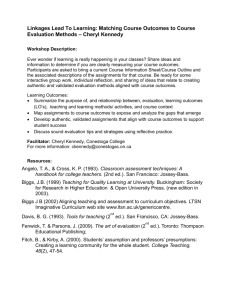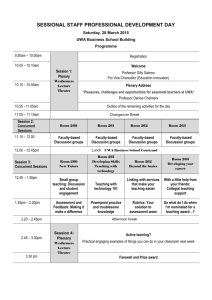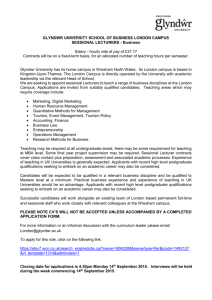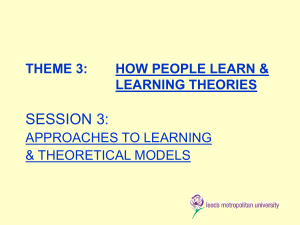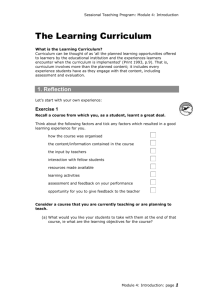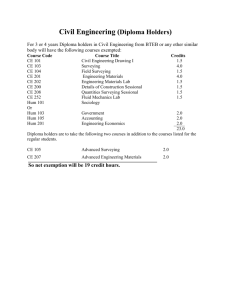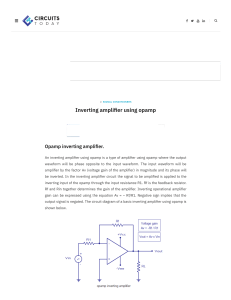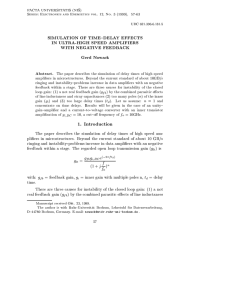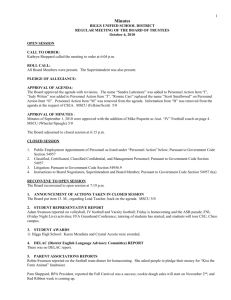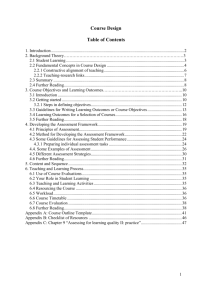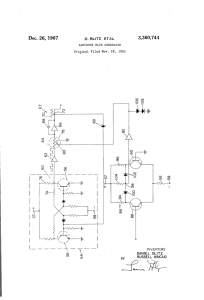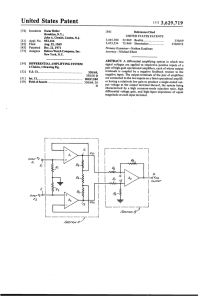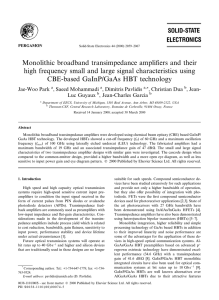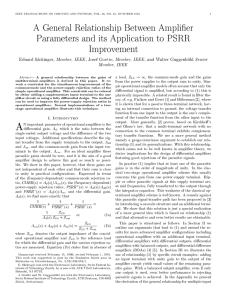Reading - University of Adelaide
advertisement
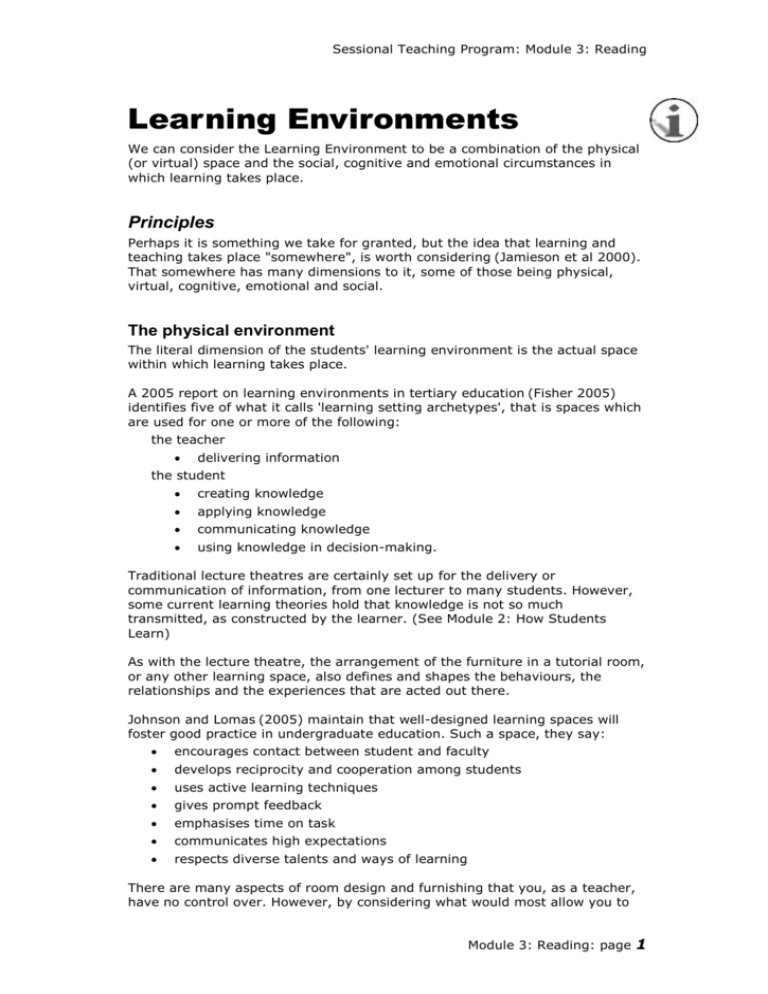
Sessional Teaching Program: Module 3: Reading Learning Environments We can consider the Learning Environment to be a combination of the physical (or virtual) space and the social, cognitive and emotional circumstances in which learning takes place. Principles Perhaps it is something we take for granted, but the idea that learning and teaching takes place "somewhere", is worth considering (Jamieson et al 2000). That somewhere has many dimensions to it, some of those being physical, virtual, cognitive, emotional and social. The physical environment The literal dimension of the students' learning environment is the actual space within which learning takes place. A 2005 report on learning environments in tertiary education (Fisher 2005) identifies five of what it calls 'learning setting archetypes', that is spaces which are used for one or more of the following: the teacher delivering information the student creating knowledge applying knowledge communicating knowledge using knowledge in decision-making. Traditional lecture theatres are certainly set up for the delivery or communication of information, from one lecturer to many students. However, some current learning theories hold that knowledge is not so much transmitted, as constructed by the learner. (See Module 2: How Students Learn) As with the lecture theatre, the arrangement of the furniture in a tutorial room, or any other learning space, also defines and shapes the behaviours, the relationships and the experiences that are acted out there. Johnson and Lomas (2005) maintain that well-designed learning spaces will foster good practice in undergraduate education. Such a space, they say: encourages contact between student and faculty develops reciprocity and cooperation among students uses active learning techniques gives prompt feedback emphasises time on task communicates high expectations respects diverse talents and ways of learning There are many aspects of room design and furnishing that you, as a teacher, have no control over. However, by considering what would most allow you to Module 3: Reading: page 1 Sessional Teaching Program: Module 3: Reading meet your goals and objectives for student learning, particularly in the way of furniture arrangement and locations of participants, you may be able to work within the constraints to arrange a room to some approximation of that ideal. The online environment The term 'learning environment' is increasingly being used with reference to online learning and teaching. At the University of Adelaide, all courses are given an online possibility in MyUni. Although it is not compulsory for lecturers to make use of this, students must be told whether or to what extent the online aspect of the course is being used. Some educators use online facilities simply as a means of delivering traditional materials in an electronic way (Oliver & Omari 2001). However, the electronic environment provides many opportunities to engage students in ways that are not possible in face-to-face encounters, both interpersonally, in discussion boards or role plays and in the vast range of information made available on the web. Possibilities for effective use of the online environment are explored in Module 10: Online Learning and on the CLPD website. However, it is valuable at this stage to think about how the good practices listed above can be implemented making use of the flexibility, interactivity and access to resources that the online environment offers. The cognitive/emotional/social environment A less tangible use of the term 'learning environment' has to do with a cluster of factors associated with what the learner and teacher bring to the situation and which shape their engagement with the learning/teaching process. These have to do with personal qualities, previous experiences, beliefs about learning, goals, values and expectations. There is considerable evidence (Biggs 2003, Ingleton 19950) that learning is more effective where students feel confident about taking risks without fear of shame or ridicule. A climate of encouragement in which expectations are clear and explicit will foster student development and autonomy. Learning environments which focus on activity by the student rather than the lecturer will encourage student involvement, shown to be a key factor in student learning7. Previous learning experiences set up certain expectations for both learner and teacher. For example, a student may expect that the teacher will provide a higher level of direction and supervision than is intended by the teacher. Issues such as this may need to be identified and addressed explicitly. The environment in which students learn has many dimensions to it, all of which can have some influence on students' learning. It is important to be mindful of the various dimensions and, as a teacher, to shape those over which you have some control. This is one of the ways in which you can make your teaching and your students learning more effective. Module 3: Reading: page 2 Sessional Teaching Program: Module 3: Reading References 1. Biggs, J. (2003) Teaching for quality learning at university: what the student does. 2nd ed. Open University Press, Buckingham. 2. Fisher, K. (ed) (2005) A report on the proceedings of two seminars on 'Learning Environments in Tertiary Education' held at Brisbane, March 2005 and Christchurch, July 2005. TEFMA http://www.tefma.com/PDFs/LearningEnvironments_Jan06.pdf 3. Ingleton, C. (1995) Gender and learning: does emotion make a difference?. Higher Education, 30, pp.323-335. http://www.springerlink.com/(h0uoeq55jaia3mfyfztlt5bm)/app/home/con tribution.asp?referrer=parent&backto=issue,6,7;journal,87,225;linkingpu blicationresults,1:102901,1 4. Jamieson, P., Fisher, K., Gilding, T., Taylor, P. & Trevitt, A. (2000) Place and space in the design of new learning environments. HERDSA, vol.19, no.9, pp.221-237. http://www.oecd.org/dataoecd/41/62/2675768.pdf 5. Johnson, C. & Lomas, C. (2005) Learning space: learning and design principles. EDUCAUSE Review, July/August 2005, pp.16-28. http://www.educause.edu/ir/library/pdf/erm0540.pdf 6. Oliver, R. & Omari, A. (2001) Student responses to collaborating and learning in a web-based environment. Journal of Computer Assisted Learning, 17 (1). http://www.blackwell-synergy.com/links/doi/10.1046/j.13652729.2001.00157.x/abs/ Further reading In addition to the above, a whole issue of the journal Higher Education in 1991 focussed on the issues of approaches to learning and learning environments. (volume 22 No.3 Oct 1991, accessible online through the Barr Smith Library) Chapter 4 of the Biggs book in the list above is on Setting the stage for effective learning. Barr Smith Library 378.125 B592t.2 O'Hare, M. (1998) Classroom design for discussion-based teaching. Journal of Policy Analysis and Management, 17(4), pp.706-720. See also these resources on the AmpliVox Sound Systems website. http://www.ampli.com/presentationtips.htm http://www.ampli.com/pdf/PocketTraining.pdf They are part of a site relating to the use of sound systems. The Pocket Training PDF contains a useful summary of possible seating arrangements and the advantages and disadvantages associated with each. Kerry O'Regan, June 2007 © The University of Adelaide Module 3: Reading: page 3






